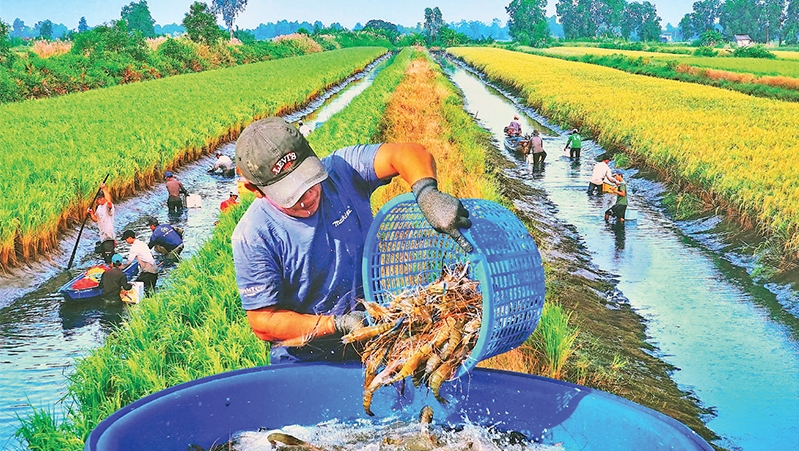New direction for Ca Mau's rice and shrimp farming
ABO/NDO – A yellow colour now pervades rice paddies in the Mekong Delta province of Ca Mau, heralding the upcoming harvest season. The joy of the farmers seems to be multiplied when rice grown in the saline fields is now recognised as a clean product.
Clean rice in saline fields
Nibbling some rice grains which had just turned yellow and were full of sweet fragrance at a corner of a paddy where rice is grown using a new method, the old farmer Trinh Hoang Cung flashed a radiating smile and said “This year’s weather is not very favourable but the rice grains are uniformly healthy. I expect the yield to be no less than 4 tonnes per hectare.”
Mr Cung is Director of the Dan Phat Cooperative, one of the first two agricultural cooperatives in Bien Bach Dong Commune in Thoi Binh District. In 2020 the cooperative cultivated ST24, one of the most delicious rice varieties in Vietnam, on 339 hectares of its shrimp farm.
 |
| Farmers harvest shrimps on a rice paddy in Ca Mau Province. (Photo: Van Doi). |
With that variety, Mr Cung’s family reaped nearly 13 tonnes from 3 hectares in 2019. Although the yield was not high, thanks to following the clean rice cultivation process, all the rice produced by Mr Cung’s family and members of the cooperatives was purchased at a price of VND7,200 per kilogram, helping increase their income from rice by 20-30%.
Thoi Binh District is the hub of Ca Mau’s rice and shrimp industry with about 20,000 hectares, accounting for nearly half of the province’s rice and shrimp farming area.
Thanks to efforts to enhance communication and technology transfer, about 70% of rice-shrimp farmers in the district have switched to rice varieties with higher quality and shorter cultivation periods, grown using organic processes.
Passports to the most demanding markets
For many reasons, some regions in Ca Mau Province have freshwater and saline water seasonally, meaning that during the rainy season, the water is fresh and during the dry season, the water is saline. This makes the land suitable for rice and shrimp farming, a model considered sustainable and in line with nature as climate change becomes more and more severe.
To date, the rice-shrimp farming area in the province has increased to over 40,000 hectares, of which Thoi Binh is the province’s rice-shrimp farming centre. Thoi Binh Chairman Ly Minh Vung said the district will continue to develop the rice-shrimp farming model in alignment with community-based tourism and adaption to climate change, noting that it is one of the three main measures decided upon by the district Party for the 2020-2025 period.
Ca Mau is adjacent to the sea on three sides so its agricultural production is highly vulnerable to the negative impacts of both weather conditions and climate change. Fully aware of such adverse effects, provincial authorities have stepped up the re-organisation of its agricultural sector.
Ca Mau Director of Agriculture and Rural Development Le Thanh Trieu said the province has decided that agricultural production must follow standard processes in order to create high-quality products certified to have met the requirements of enterprises and the market, and avoiding a situation in which farmers grow whatever they want and follow only traditional practices.
This orientation is expected to help Ca Mau penetrate into the highly promising market segment of clean and safe agricultural products. To date, Ca Mau has successfully built several areas specialising in rice and shrimp farming linked with production and market chains with a combined area of 15,000 hectares, accounting for 19% of the province’s total rice farming area.
Among the ten production and market chains established in Ca Mau, about 700 hectares of organic rice now meet US, EU and Japanese standards, the highest in the world. With these passports, rice and the other agriculture produce of Ca Mau will have more leeway for export to the most demanding markets in the world.
(Source: NDO)
 về đầu trang
về đầu trang







